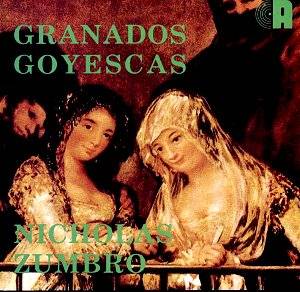Nicholas Zumbro shows
fine affinities with Spanish music –
its colour and rhythm – in this invigorating
selection. In the music from Goyescas,
which really can’t withstand indifferent
technique or limited expressive nuance
or, in the final resort, insufficiently
taut rubati, Zumbro gives us more from
Book I than Book II. El Pelele
receives an appropriately brillante
reading and in Los requiebros
his rhythm is excellent and rubati are
natural and flexible. Coloquio en
la reja, the earliest written of
the set, is a long and demanding piece,
and one prone sometimes to deflating
lack of contrasts and a lingering tempo.
Zumbro manages to preserve a certain
wistfulness without sacrificing momentum
– his tempo is relatively forward moving
and importantly he manages to mark the
transitions with a degree of seamless
intent. His Allegretto section, often
a pianistic downfall with executants
making a real meal of it, is excellent
– witty rhythms, chordal strength and
drama. El fandango de candil is
well argued, its Spanish rhythms subtle
and effectively realised and it’s splendidly
assertive, though perhaps not quite
fff at the climax.
Quejas ó
la maja y el ruiseñor (The
Maiden and the Nightingale) is
not over-scaled or allowed to ramble;
its relative tautness is not however
an indication of expressive indifference
because it’s lyrically phrased and the
rubati, as ever with Zumbro, are unforced.
Many tend to make the nightingale’s
final notes rather outsize; not here.
It’s important that a sense of quasi-improvisation
courses through these settings without
endangering the sense of the spine of
the music (Granados after all was a
famous improvisator). Just such a sense
can be gleaned from El amor y la
muerte from Book II in which the
colours are newly liberated and in the
Epilogue, Serenata del espectro where
a sense of aeration co-exists with the
more distanced and baleful qualities.
As a bonus there are two previously
unrecorded items, Crepusculo
and Intermezzo in their arrangements
for piano. The former, left behind in
manuscript at Granados’ death, has some
glinting Zumbro treble runs, a sensitively
judged climax and brisk rhythm whilst
the latter, a famous piece better known
in versions for band and for violin,
I suppose, receives an expressive reading.
The two de Falla pieces,
less well known ones, from El Amor Brujo
make fine makeweights – I particularly
admired Pantomine where Zumbro
catches the sense of inflexion and curious
stasis in the music. The recording,
in St Silas Church, London, is good
but sometimes inclines to hardness and
closeness – there’s not much air at
climaxes – but it’s not really a problem.
The performances themselves are certainly
convincing.
Jonathan Woolf
MusicWeb
can offer the complete
Concert Artist catalogue
